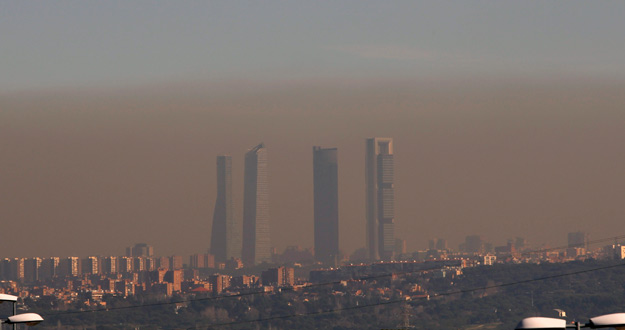I remember when I lived in Madrid --during many years--, which had a lot of pollution, when they had spent many days, with good weather. In those years, there were 4 skyscrapers, that you can see, in the picture, below; but, I do remember the "beret", which set over the city.

An iron oxide, called hematite, like those that give a characteristic reddish colour, to Mars or River Tinto, has a capacity, that can help to reduce pollution, produced by gases emitted in exhaust and factories.
The compound is capable of reducing the presence of nitrogen oxides, ie, the gases released to air, by combustion and which generate, in the atmosphere, for example, the brownish Beret, that Madrid has, when there is a lot of contamination and a stable weather.
So it has been shown, by researchers from the group of Inorganic Chemistry of the University of Cordoba (South of Spain), who have described a process, that can help create solutions, for this type of air pollution. The details are published, in the journal Applied Catalysis B: Environment.
Nitrogen oxides (NOx, as they are also known) are polluting gases, produced by industry and transport, which can cause respiratory diseases, such as emphysema or bronchitis.
Conventionally, it is generally, to reduce the effects of NOx, into the atmosphere. Even commercial products, using this compound between its components, are marketed; but its price is quite high.
"It is an excellent solution; but the main photocatalytic activity of titanium oxide occurs only with certain conditions of the presence of ultraviolet rays", explains the, Luis Sánchez Granados.
Therefore, this material is useful, in cities with many hours of sunlight, as Madrid or Barcelona; but it is not so, in urban environments, with limited solar incidence or located in northern and central Europe or North America, with more cloudy days and low levels of UVA rays.
In this context, the scientific community has begun a way, to find more efficient alternatives, in recent years. Different compounds are being tested, in laboratories around the world, right now.
In addition to the ability of removing gaseous pollutants, researchers also consider the availability of materials.
In the towns and large cities, are produced the most nitrogen oxides, that pollute air, largely expelled to air from the exhaust pipes of motor vehicles.
Only a large scale will help fight this air pollution. "The iron oxides are abundant, in nature, and they include both environmental and chemical characteristics, that make them attractive, for use as photocatalysts", says Sánchez Granados.
Specifically, the group of UCO has explored capabilities of the hematite, whose formulation is Fe2O3. It is the first time that a scientific team used this material for decontamination of harmful NOx gases.
This iron oxide is quite common, but it can also be found in nature crystallized by complex geological processes, such as forming diamonds.
Hematite gems produced are valued in jewelry. Chemists reproduced some of these processes, in the laboratory, and tested mineral photocatalytic capabilities.
Thus, they could confirm that the hematite was an efficient material, for removing nitrogen oxides air polluting.
The Professor, Luis Sanchez, in order to transfer this new knowledge to industry, has recently presented these results, at the European seminar Ligh2CAT.
At this meeting, held in April, in Valencia, several companies and institutions discussed new to reduce air pollution.
Well, I hope that you think it is as interesting as I did.
Until my next post, kind regards,
Luis.
Sponsored by Costaluz Lawyers.
Please click below:
